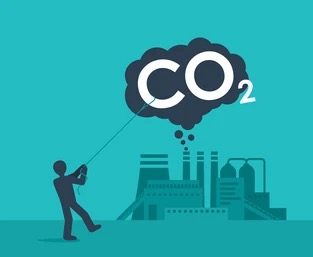Climate change is a relevant danger to our society today, threatening individual lives, nations of all kinds, and the earth itself. Numerous proposals have been made in order to save our planet from this threat, including regulation of greenhouse gas emitters, adaption methods to mitigate damages, and usage of renewables and green tech to provide clean energy in lieu of fossil fuel. However, another method for fighting global warming, first materialized in the 1970s but recently attracting both popularity and controversy, could prove the most potent solution to the threat of warming today. Carbon capture, coming in many different designs and plans, has been advertised by its proponents as a technology which can almost entirely eliminate emissions from fossil fuel burning procedures while still maintaining the fossil fuel industry itself and the benefits sourced from it. However, numerous challenges still remain concerning both the efficacy and feasibility of this technology, with carbon capture in truth holding vast potential to either benefit or hinder our struggle against climate change.
To start with the forwarded benefits, the most decisively urgent motivator for adopting carbon capture is quite clearly global warming. Caused by increasing levels of greenhouse gas emissions which trap heat in the planet’s atmosphere, climate change threatens the earth with rising temperatures, and as such, catastrophic disasters such as hurricanes and wildfires, along with a massive loss of life.
Carbon capture, defined by the International Energy Agency, as “capture of CO2” which is then “compressed and transported by pipeline, ship, rail or truck to be used in a range of applications, or injected into deep geological formations,” could, if successful, sequester vast stores of carbon dioxide emissions, and in the process directly reduce the rate of warming. One of the most transformative kinds of carbon capture, direct air capture, wherein carbon is actively removed from the atmosphere, has demonstrated steady improvement. According to a jointly written article from Nature Energy, the specific technology’s efficiency reached up to 93.1% as of even three years ago. With investment and research into this technology having only increased since this study, carbon capture’s potential for decreasing emissions sourced from both industry processes and the atmosphere has only improved.
However, opponents of carbon capture have raised numerous concerns, not the least of which is a refutation of the technology’s core solvency. Citing historical examples, critics such as the Institute for Energy Economics and Financial Analysis have identified that carbon capture, a technology first formulated in 1938 and implemented in 1972, has historically failed to meet carbon goals, with less than a quarter of all carbon capture programs meeting proposed standards since its first implementation. Many have also cited systemic issues in the technology as a whole, with Food and Water Watch pointing out the technology’s liabilities for both leakage of stored carbon and vast energy usage and emissions which outpace any emissions stored. This startling truth, that carbon capture currently is net responsible for more emissions than it solves, indicates one of the key proposed failings of carbon capture.
Defenders of carbon capture have in response cited imminent innovation in the field as the remedy to these concerns, likely to improve the efficiency and effectiveness of implementation. To begin, many have noted that the solvents utilized in the process of carbon capture can be made more energy efficient, increasing net carbon reduction and reducing price. An article from Decarbonization Technology discussed both past and prospective improvements in numerous solvent applications, noting that specifically ionic liquids, a powerful type of solvent, “have shown incredible potential for CO2 absorption, have negligible vapor pressure, have adjustable structures, and are eco-friendly.” Should these new solvents prove successful, they will not only improve the rate of carbon reduction, but remove from the process the aforementioned emissions which currently make carbon capture unsustainable. Moreover, entirely new processes have also been introduced, including cryogenic and electrochemical carbon capture, both of which according to the previously discussed article, have vast innovative prospects. Although further investigation into these new solutions is necessary, there is no doubt that to reject these technologies on face value due to past failings could foreclose groundbreaking new methods to combat global warming. Even if carbon capture may not currently be an optimally efficient solution, approaching technological advancements could very easily mitigate such challenges, and should by no means be discounted.
In spite of calls for further innovation however, many detractors still refuse the possible validity of carbon capture. Carbon capture has indeed been afforded half a century to develop, and many point out that to depict the technology as new and full of budding progress ignores not only its long history of failure, but also its relative stagnation when considering “new” supposed innovations. Admittedly, as discussed by the Bulletin of the Atomic Sciences, carbon capture and similar technologies have already undergone extensive waves of innovation, being previously used for submarines and space travel before ever being dreamed up as a remedy for global warming. Although this does demonstrate previous improvements, the article then goes on to track a decrease in the feasibility of future developments, with the most straightforward, profitable, and affordable innovations having already been pursued. This leaves the industry only with the most infeasible and expensive routes to improve carbon capture, decreasing not just the chance these innovations will be actualized, but moreover the chance business leaders will even find it profitable to pursue them. Moreover, specific construction and infrastructure costs have also “relentlessly increased with cumulative investment,” with little room for improvement in cost efficiency. As such, the more investment is poured into material projects, the less benefits are accessed as a result. Though future innovations could prove current criticisms wrong, such developments are, due to current industry trends, unlikely to arrive.
Setting aside if carbon capture actually proves solvent, an important result of carbon capture implementation that should decidedly be considered is the likely continuation of fossil fuel industries. Many of the largest producers of oil and natural gas, including Exxon Mobil and Chevron, have not only invested in, but also have advertised the technology extensively, with the S&P Global tracking carbon capture projects from these fossil fuel giants as early as 2021. Should carbon capture prove successful in mitigating the harms that otherwise stem from the industry, fossil fuel companies would not only be able to boast successful projects in the fight against climate change, but also maintain their existing structures of business. The fossil fuel business directly employs, according to analysis by Brookings, as of 2019, nearly 1.7 million people, or over one entire percentage point of the American labor market, and the wages and resources sourced from the industry are responsible for countless more. Moreover, fossil fuel jobs are not spread equally throughout the economy, instead being localized in specific parts of the nation where the economic consequences of their loss would be even more disastrous, with the same labor analysis done by Brookings also identifying that “In certain counties in West Texas, Oklahoma, Wyoming, North Dakota, and West Virginia, 30% to 50% of all workers are employed in these industries.” The outsized impact of fossil fuel production and its economic benefits on these regions means that the decline of the fossil fuel industry could potentially result in not only a substantive loss of overall economic prosperity in the national economy, but also total economic degradation in the most reliant areas of the country. With carbon capture and storage being presented as a method of both maintaining this profitable industry while decreasing one of its greatest harms, the technology’s implications could reach well beyond warming prevention alone.
Just as carbon capture would likely preserve the benefits of the fossil fuel industry, so too would it in the process propagate the industry’s downsides. Foremost amongst these are the environmental harms of fossil fuels aside from carbon emissions. The Environmental and Energy Study Institute has made clear that entirely separate from carbon emissions, fossil fuels are also responsible for amongst other environmental threats, non-carbon-based air pollution, water pollution, plastic pollution, and oil spills. These pollutants, released in harvesting, refinement, and actual usage of fossil fuels, have been tracked as threats to the well-being of local environments, undermining habitats and biodiversity, and the health of countless victims of pollution throughout the nation and globe. Beyond even just the environmental harms of fossil fuels, the Fossil Fuel Non-Proliferation Treaty stressed in an extensive report, how the fossil fuel industry undermines through its practices, each of the United Nations seventeen sustainable development goals, all of which are as the United Nations itself clarifies, frameworks to guide the world in such varied goals as combating poverty, improving healthcare and education, and spurring overall economic growth. Although it ought to be recognized that the manner by which the fossil fuel industry has undermined these goals is oftentimes due to climate change, it just as often is not, with fossil fuel extraction and use being statistically linked to decreased human welfare, increased conflict, and overall weaker democratic institutions. Taking these varied factors into consideration, any analysis of carbon capture must also account for the fact that long-term implementation of the technology will also propagate the larger fossil fuel industry’s benefits and detriments.
Ultimately, carbon capture in its current state is best defined as ambiguous. It could be used to solve the menace of warming, or it could result in further consumption and emissions. It could be a field on the cusp of transformative breakthroughs that change the way we interact with the global climate, or it could be a technology with near no ground for future innovation. It could allow us to maintain the economic benefits of an industry responsible for a large portion of the national economy, or it could continue the environmental and societal harms sourced from the industry which has now become one of its most vocal proponents. As the future of carbon capture progresses, these ambiguities will become increasingly clear, and with them, so too will further knowledge and understanding of the technology whcih could make or break our national climate policy.









